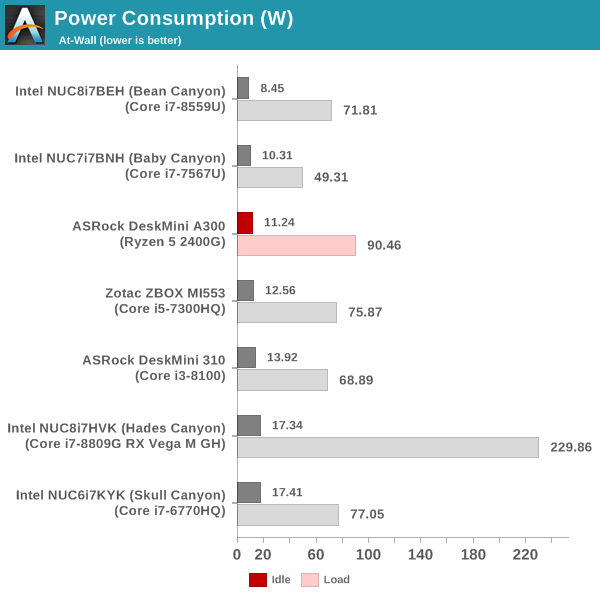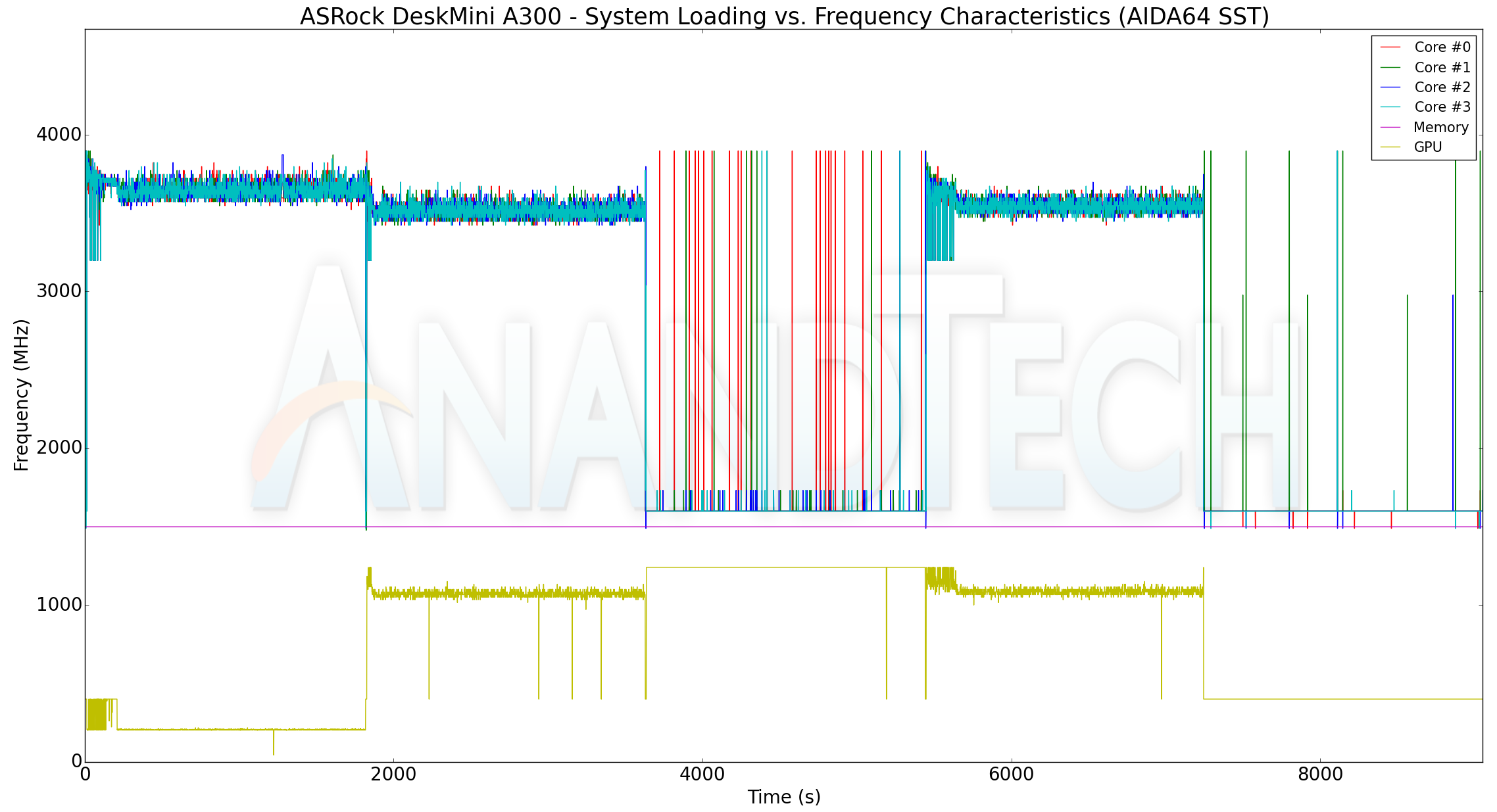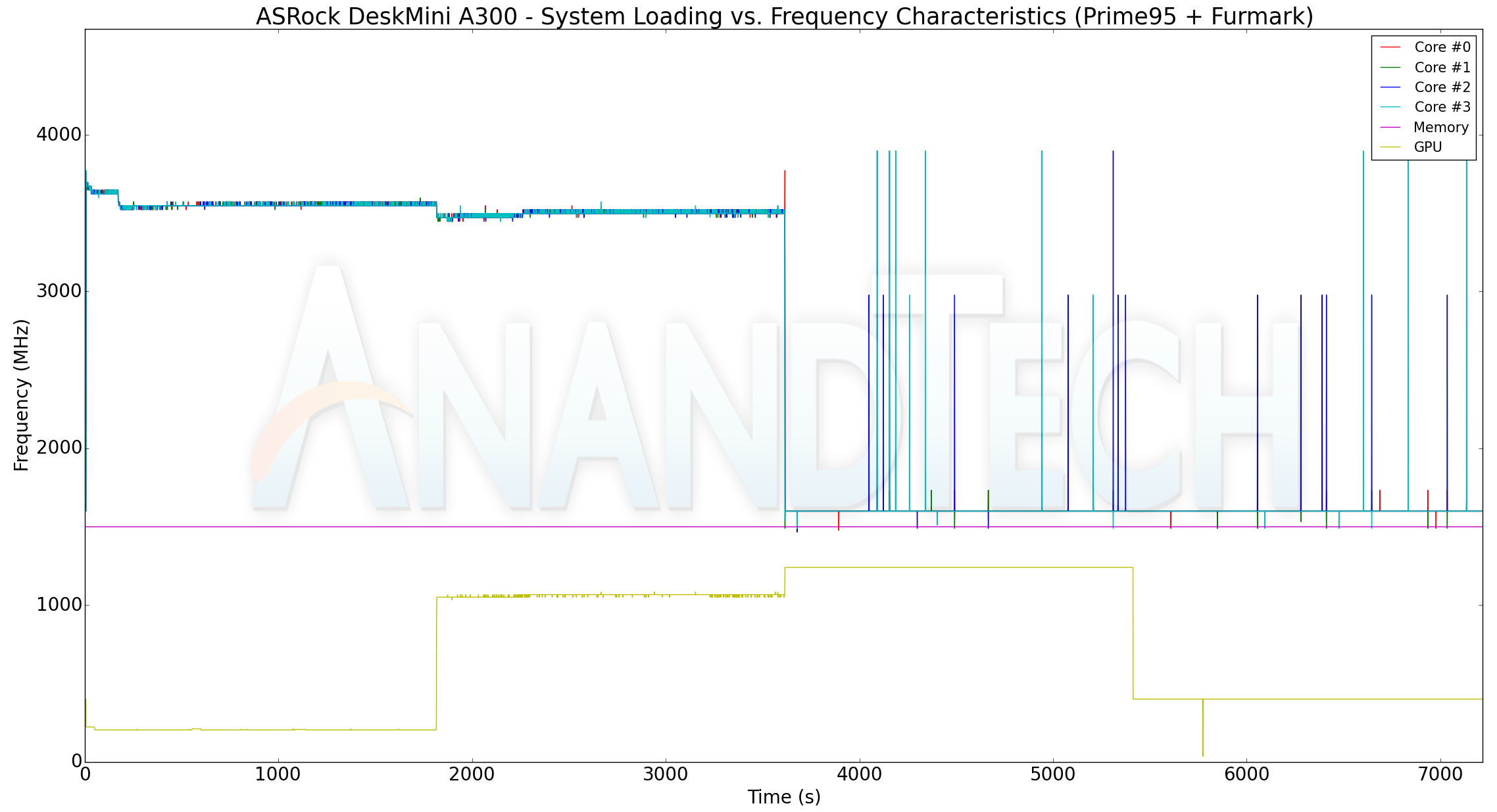The ASRock DeskMini A300 Review: An Affordable DIY AMD Ryzen mini-PC
by Ganesh T S on April 26, 2019 8:00 AM ESTPower Consumption and Thermal Performance
The power consumption at the wall was measured with a 4K display being driven through the HDMI port. In the graphs below, we compare the idle and load power of the ASRock DeskMini A300 with other SFF PCs evaluated before. For load power consumption, we ran the AIDA64 System Stability Test with various stress components, as well as a combination of Prime95 and Furmark, and noted the maximum sustained power consumption at the wall.

The key comparison here is against the DeskMini 310. Thanks to the use of a more power-efficient NVMe SSD, and the A300 PCH that essentially acts as a transparent bridge, the idle power consumption of the DeskMini A300 is a full 2W lower than the DeskMini 310. The load case, however, is completely different. We see the DeskMini A300 sustaining more than 90W at the wall. This number is higher than the load consumption of any other iGPU-only system we are comparing against.
Our thermal stress routine starts with the system at idle, followed by four stages of different system loading profiles using the AIDA64 System Stability Test (each of 30 minutes duration). In the first stage, we stress the CPU, caches and RAM. In the second stage, we add the GPU to the above list. In the third stage, we stress the GPU standalone. In the final stage, we stress all the system components (including the disks). Beyond this, we leave the unit idle in order to determine how quickly the various temperatures in the system can come back to normal idling range. The various clocks, temperatures and power consumption numbers for the system during the above routine are presented in the graphs below.
| ASRock DeskMini A300 System Loading with the AIDA64 System Stability Test | |||

At the start of our stress routine, we see most of the cores at the boost clock (3.9 GHz), but, the temperature quickly approaches 78C. The DeskMini A300 BIOS seems to treat that as the indicator to bring down the cores to the base clock of 3.6 GHz. In this initial period, the package power (labeled as reported, but, is more likely to be the power consumption of the x86 cores alone) is around 35W. That drops down to 30W after the cores go back to the base clock. After adding the GPU loading, the cores clocks do go down a bit to around 3.4 GHz (as the GPU ramps up from around 200 MHz to around 1.1 GHz). The reported package power remains constant at 30W. Unlike the reported package power, the at-wall power consumption provides hard irrefutable numbers. In the boost clock state, the wall power goes as high as 80W before settling down to around 72W. When the GPU load is added, the metric stabilizes around 85W. If the GPU alone is loaded, the core clocks jump down to 1.6 GHz, and the GPU starts running at the rated clock (1250 MHz). The at-wall consumption is around 43W. When stressing everything in the system, the added storage workload slightly bumps up the at-wall consumption by a couple of watts, but, other metrics remain similar to the second stage. The temperature of the cores never exceed 80C at any point in the AIDA64 system stability test.
We also run a custom stress test involving Prime95 and Furmark. Starting with Prime95 alone, we add Furmark to the mix after 30 minutes. After another 30 minutes of simultaneous CPU and GPU loading, we terminate the Prime95 process alone and let the GPU run at full throttle. The metrics graphed for the AIDA64 system stability test are also graphed here.
| ASRock DeskMini A300 System Loading with Prime95 and Furmark | |||

Interestingly, Prime95 doesn't trigger the boost clocks for the cores. Otherwise, the loading characteristics for the frequencies, temperature, and power are largely the same as what we observe with the AIDA64 system stability test workloads. The only thing of note is that Prime95 and Furmark together make the system consume north of 90W at the wall.
The thermal solution is very effective, ensuring that the temperatures never cross 80C while allowing the APU's CPU cores and GPU to operate at the advertised frequencies / rated power consumption. The 90W peak power consumption also indicates that the Ryzen 5 2400G is operating at its rated TDP of 65W in the DeskMini A300.










88 Comments
View All Comments
Haawser - Sunday, April 28, 2019 - link
@oliwek That's the 310, it's an Intel barebones system, not Ryzen.sor - Saturday, April 27, 2019 - link
If you sign up for Newegg notifications you’ll probably have one within a week. I got one of mine about three weeks ago and the other last week.yankeeDDL - Monday, April 29, 2019 - link
I'm just going to throw it as a suggestion.I understand the purpose and the rationale in comparing similarly priced models, and all relatively recent/available, however ... I think it would add an enormous value to "normal" users to be able to somewhat put things in perspective with slightly dated hardware.
I am not saying that we should be able to compare the Ryzen 5 2400G with an 80486, but, to give you an example, I have an A10-8700P and I have been considering an upgrade, but it seems really difficult to find a way to get an idea of just how much faster the 2400G is.
The A10-8700P is certainly not efficient, but it does have 4 cores, and a decent iGPU, already based on the GCN. There's no question that the 2400G will trounce it in efficiency, but is it a worth upgrade?
It is just an example, to indicate that having also 2-3 previous generations in the comparisons would not be such a bad idea, in my opinion. Just a thought.
Irata - Wednesday, May 1, 2019 - link
If you are looking for this type of comparison, planet3dnow de has one between an Athlon 5350 (Jaguar) vs Athlon 200GE. It's in German but maybe you can get useable results using Google translate.They also did a review of the Hewlett-Packard 17-ca1004ng notebook with a Ryzen 5 3500U comparing it to its Bristol Ridge predecessor.
Both show just how far AMD has come with Ryzen.
mikato - Tuesday, April 30, 2019 - link
Ganesh, you didn't talk about noise at all. I feel like that should always be included in these mini PC articles. You have 3 pages on HTPC credentials and 1 page on Power Consumption and Thermal Performance but no mention of noise. How does it compare to the Intel NUC8i7BEH that you mentioned had a noisy fan with any load? Or the ZBOX CI660 which was fanless but had a dull whine and a strange grating sound though it wasn't noticeable beyond 10 feet? Did you think that optional CPU heatsink/fan they included was adequate?By the way, 10 feet isn't close enough. How about 6 feet? If you give one noise impression from 10 feet, you could move a few feet closer and check what it is at 6 feet as well... for future reviews.
If you keep doing these Mini PC reviews, I will keep reading them!
Lucky Stripes 99 - Sunday, May 5, 2019 - link
I was also puzzled at the lack noise testing. One of the reasons I'm looking at mini-STX and thin mini-ITX systems instead of a NUC is because of the fan noise many of those NUC systems suffer from.Some folks have been installing low-profile Noctua CPU coolers in their Deskmini systems and they report that they are "nearly silent", even while under heavy load. I'd really like to know how silent that really is.
werpu - Monday, May 6, 2019 - link
I have a ryzen 2400g mini itx system with the flat noctua, and it is very silent, even under heavy load it is almost not hearable. I however had to add 2 smaller noctuas later in my system because the vrm would get rather hot with my standalone noctua and the case I was using. Still a very silent system and definitely less noise than a nuc.mikato - Tuesday, April 30, 2019 - link
At first I thought Bean Canyon was the best way to go for an HTPC with the performance and power efficiency. But with an idle power usage of 11.24 watts for this DeckMini A300 vs the 8.45 watts of the NUC8i7BEH with Bean Canyon - that difference is so little. As my HTPC, it would be left on and most of the time it would be idling. And the "as configured, no OS" prices in your reviews for these were $465 for the DeskMini A300 and $963 for the NUC8i7BEH...Let's see, your DeskMini A300 had:
G.Skill Ripjaws F4-3000C16D-16GRS 2x8 GB (newegg $100)
Western Digital WD SN500 500 GB (newegg $70)
While your NUC8i7BEH had:
G.Skill Ripjaws F4-3000C16D-32GRS 2x16 GB (newegg $185 - your review listed RipjawsV F4-3000C16-16GRS but I couldn't find that anywhere and the photos in your NUC8i7BEH review showed it was F4-3000C16D-32GRS instead so I think your specs table was incorrect)
Western Digital WD Black 3D NVMe SSD (2018) 1 TB (newegg $238 for the SN750, older 2018 one costs more)
Let's see... that's $185-100=85 and $238-70=168. 85+168=253
So your combined storage and memory choices for the NUC8i7BEH cost $253 more.
And the difference in your overall "as configured, no OS" prices was $963-465=498.
So if I remove the difference in your storage and memory choices, I calculate that the DeskMini A300 is still $498-253 = $245 cheaper!
Sure the A300 doesn't look as nice or compact as the NUC, but that is some solid money.
Irata - Wednesday, May 1, 2019 - link
The Intel models are usually configured with higher end components vs. the AMD based models. Same for laptops where $600 AMD based notebooks go up against $1,600 Intel ones .I guess it's a hold over of the "AMD = budget" days.
mikato - Thursday, May 2, 2019 - link
Well, it's not a laptop. What do you think might be a higher end component here? This is basically a case, motherboard, and power supply, right?